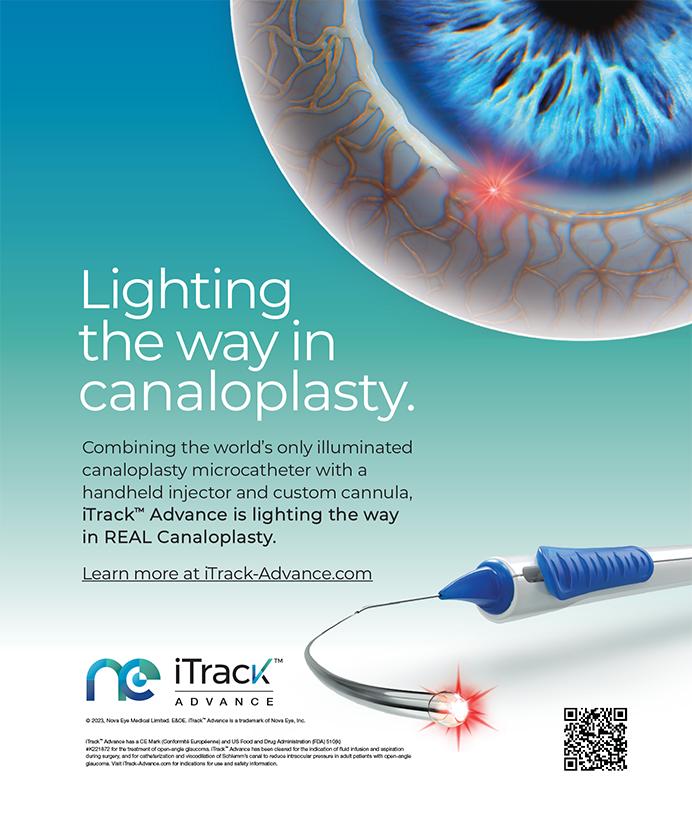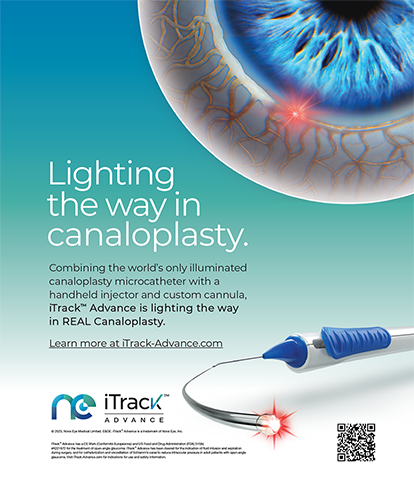Cover Stories | Jun 2005
Clinical Pearls for Using the Restor
Candidate selection and surgical planning with this apodized diffractive IOL.
David Allen, BSc, FRCS, FRCOphth
The European surgeons such as myself have considerable experience with the Acrysof Restor apodized diffractive implant (Alcon Laboratories, Inc., Fort Worth, TX), because the lens received CE Marking that allowed its clinical use in the summer of 2003. Remarkably, the clinical results with the implant have been at least as good as those obtained during the formal studies performed for regulatory approval. I ascribe this success to three factors: the implant's performance, the careful selection of patients, and the surgical technique of the ophthalmologists implanting the IOL.
PATIENT SELECTION
Hyperopes Versus Myopes
Although this IOL provides better reading vision with fewer unwanted visual effects than other bifocal/multifocal IOLs currently on the market (based on data submitted to the FDA in support of approval for the Restor, Array [Advanced Medical Optics, Inc., Santa Ana, CA], and the Crystalens [Eyeonics, Inc., Aliso Viejo, CA]), the careful selection of patients is still important. Candidates must truly wish to be free from spectacles.
Patients who have age-related cataracts and who are hyperopic are the best candidates, because they will be delighted with their postoperative unaided distance vision. Having unaided near vision as well will prompt them to rave about their results to friends and family. I recommend that surgeons first implant the Restor in this subset of patients before working with more challenging patients such as low myopes, who always had unaided near vision until they developed cataracts.
Surgeons should reject patients whom they cannot guarantee a low level of postoperative astigmatism. The clinical studies required less than 1.00D of preoperative keratometric astigmatism for all subjects. The company now recommends that surgeons use the Restor only when they can reasonably expect to achieve less than 1.00D of astigmatism postoperatively.
Ophthalmologists may want to consider the Restor for refractive lens exchange, although the FDA has not approved the IOL for this indication. Again, it would be advisable to begin with hyperopes, because this lens will significantly improve their distance vision, even if their final refractive outcome is slightly off target. Myopes without significant astigmatism, however, will have clear, unaided vision at some relatively near distance despite their presbyopia. To satisfy these individuals, the surgeon must obtain an excellent refractive outcome.
Reading Vision
The Restor lens features a 4.00D add at the IOL plane (around 3.20D at the spectacle plane). One reason for this relatively large add is that it increases the spatial separation of the two images and therefore decreases the influence of the out-of-focus image on the focused one. As a result, patients' reading distance is best at approximately 31 to 32cm.
Cataract patients over the age of 60 years have become accustomed to absolute presbyopia and a fixed reading distance of approximately 36cm (with a typical 2.50 or 2.75D spectacle reading add). Developing presbyopes, on the other hand, have gradually increased their reading distance to compensate for their growing loss of accommodative amplitude and may have become used to a reading distance of arm's length or greater. Practitioners therefore must carefully prepare early presbyopic patients for a dramatic reduction in their best reading distance. In my clinical experience, however, patients' reading distance gradually extends a little and, after a few months, is probably nearer to 34 or 35cm. The reason for this change is unclear.
SURGICAL CONSIDERATIONS
Binocularity
The binocular implantation of this IOL is recommended by the manufacturer. Most measures of visual function improve when measured binocularly, and patients are generally more comfortable when both of their eyes have broadly similar function. With the Restor, my colleagues and I have found that patients' binocular distance and reading performance is approximately one line better than the best uniocular result. Uniocular implantation in binocular patients is not absolutely contraindicated, but the surgeon and patient need to be aware that the results will not be quite as good.
Planning
Ophthalmologists wishing to use the Restor implant should already have a consistent surgical technique, be familiar with using the Acrysof SA60 platform (Alcon Laboratories, Inc.), and be sure that they and their surgical team can routinely achieve the predicted refractive outcome. If the goal is to leave the patient independent of spectacles, then surgeons must be confident that they normally free patients from glasses for distance vision.
Using the correct A-constant is important. The company recommends an A-constant of 118.4 for ultrasound biometry with the standard SA60 lens but one of 118.2 for the Restor. Surgeons should similarly adjust their individualized A-constants or the one that they employ with the IOLMaster (Carl Zeiss Meditec Inc., Dublin, CA). This change is needed partly because the posterior surface of the IOL was made aspheric to improve the quality of the optical image.
Targeting a postoperative refraction that is slightly hyperopic (0 to +0.50D) tends to increase patients' reading distance without compromising their unaided distance vision. This technique also reduces the incidence of unwanted nighttime visual phenomena, because the near image is more out of focus.
Technique
The surgical technique is the same as that for implanting a standard SA60 IOL. The capsulorhexis should be centered, round, and 5.0 to 5.5mm in diameter so that the anterior capsule overlaps the IOL's anterior edge and thus reduces the incidence of posterior capsular opacification. It is best to insert the Restor lens with a cartridge, preferably the Monarch II IOL Delivery System with a B cartridge (Alcon Laboratories, Inc.). When removing the IOL from its packaging and transferring it to the cartridge, the surgeon should be careful to grasp the haptic or, if necessary, the optic close to its edge so as to avoid any possible damage to the diffractive grating, which occupies the central 3.6-mm diameter of the lens' anterior surface. This cartridge will fit snugly into the entrance of a 2.75-mm corneal incision.
It is, of course, important to ensure that the IOL sits securely within the capsule and that all viscoelastic material has been removed. With a strongly cohesive viscoelastic, directly aspirating behind the IOL optic is not necessary if the surgeon rocks and nudges the lens when aspirating the viscoelastic. If using a retentive substance such as Viscoat (Alcon Laboratories, Inc.), then one should directly aspirate the material from behind the optic. Once the haptics have fully returned to their preinsertion configuration, the ophthalmologist should ensure that the IOL's optic is centered, because the position of the lens will not change postoperatively (Figure 1). Regarding the lens' ability to provide two good-quality images, a decentration of up to 1mm does not degrade optical function, but, in general terms, it is important to ensure the centration of the IOL's optic.
CONCLUSION
Although bifocal and multifocal IOLs have been available in different markets for almost 20 years, they have never had a major impact in terms of the proportion of patients receiving such lens technology. The combination of diffractive optics with apodization present in the Acrysof Restor IOL provided excellent unaided vision and freedom from spectacles for 85% of subjects who received the lens during the FDA clinical trial. This IOL should significantly affect the future of cataract surgery, but it still requires carefully selected patients and a meticulous surgical technique.
David Allen, BSc, FRCS, FRCOphth, is a consultant ophthalmologist specializing in cataract surgery in Sunderland, England. He has received reimbursement from Alcon Laboratories, Inc., for travel and lodging but states that he holds no financial interest in the products or companies mentioned herein.
Mr. Allen may be reached at +44 191 5699071; david@allen50.fsnet.co.uk.


